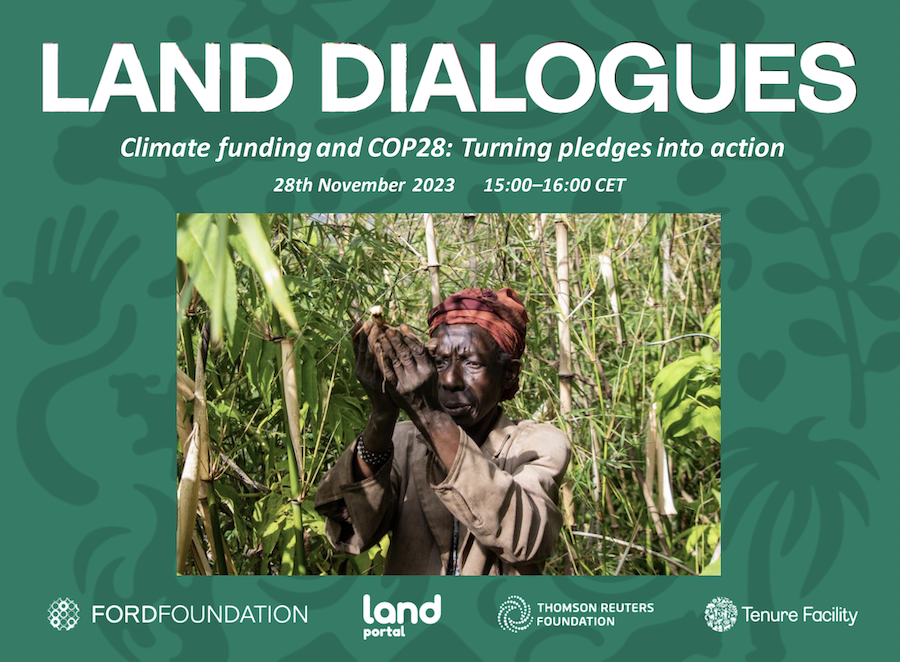Under the umbrella of the Land Dialogues series, the third webinar of this year’s series “Climate Funding and COP28 : Turning Pledges into Action” took place on November 28th, 2023. The webinar drew in a little under 200 participants and featured panelists from Indigenous leaders to donors. The series is organized by a consortium of organizations, including the Land Portal Foundation, the Thomson Reuters Foundation, the Ford Foundation and the Tenure Facility.
Thin-Lei Win, journalist, Food Systems and Climate Change, moderated the panel, which featured the following speakers:
- Casey Box, Director of Global Strategy, Christensen Fund
- Deborah Sanchez, Director with the Community Land Rights and Conservation Finance Initiative (CLARIFI)
- Jenny Lopez, Land Governance Advisor, UK’s Foreign, Commonwealth and Development Office (FCDO)
- Valeria Paye, Head of the Executive Board of Podáali - Indigenous Fund of the Brazilian Amazon
- Josimara Melgueiro, Coordinator of the Rio Indigenous Fund
Please see a brief recap of the full captivating conversation.
Last year, we reflected on donor promises to Indigenous communities. Where are we now? What is one key win and one major obstacle since last year’s COP?
More IP and LC led organizations are being directly funded than we've ever seen before. It is not just about the 1.7 billion that was pledged at COP26 and it is not just about the money in itself. It is about how we are working together as donors as IP and LC organizations, other partners, civil society organizations. We are seeing a level of dialogue, collaboration and discussions between all of those stakeholders in ways that really had not happened before. It has been really exciting. At recent COPs in Montreal and New York, we have had leaders from government alongside the stage with IP and LC leaders, with civil society organizations in a way that was not happening previously. Particularly in New York at Climate Week last month there were ministers from Norway alongside ministers from Brazil, which we didn't even have that minister for IP and LCs . This means there is an accountability commitment from donors, which again, we did not have before on this issue.
The challenge, however, still exists. We know that in 2021, only 7% of that pledge out of Glasgow went directly to Indigenous peoples and local communities. If we dig deeper into those numbers, it is even less than 7%. The challenge still exists on the donor side. There is more that needs to be done to create more flexible funding. We need to allow Indigenous Peoples and local communities to define for themselves what they view as direct funding and financing.
We now have multiple Indigenous-led funds. What are these funds and what is a general overview.
We have been seeing global, regional and national financing mechanisms that are being built and governed by Indigenous Peoples and local communities. At the global level, for example, we are seeing the Community Land Rights and Conservation Finance Initiative (CLARIFI) that is being incubated in the Rights and Resources Initiative and with the technical support of Campaign for Nature. Then we have the regional and national funds. We are seeing Podaali, Nusantara, the Mesoamerican Territorial Fund and AMAN’s territorial fund and many others. CLARIFI is giving grants to them so that they can build their capacities. For example, with AMAN in Indonesia, some of these funds will go to strengthen the capacity of some of the chapters of their organizations. These funds are beginning to work in complementarity to each other.
The good news is that funds are being disbursed. But how they are being spent and targeted still needs to be improved to reach Indigenous peoples at scale. What can change this?
First of all, funds need to be disbursed more quickly and in a way that we can really build a more effective longer term mechanism. There are ways that we need to be working, perhaps with intermediaries and trusted partners, to make sure that things can happen at scale more quickly, which means that IP and LC organizations can really receive that money more directly and in a way where they can have more influence and control. There are different views on whether discussions around capacity building are really fair, because that is in a sense asking IP and LC led organizations to adapt to donor requirements to some extent. We are also accepting that some donors, particularly bilateral donors, will always have some red tape in terms of reporting and accountability. Understanding where those red lines are and trying to dig deeper as to where there are also the yellow lines, where can we shift and where can we adapt. That will be progress. We also need to recognize that given that we have this collaboration now between philanthropic and bilateral donors, where can we actually collaborate together to understand that there are opportunities for philanthropic organizations to fund things at different stages to bilateral donors, and there is also work that bilaterals will be funding that perhaps philanthropic organizations may or may not.

